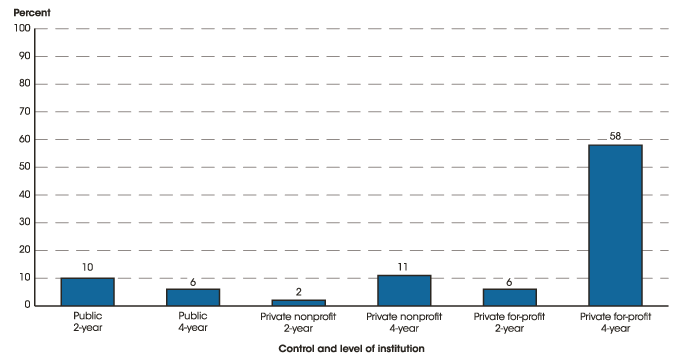By Lauren Musu-Gillette
Distance education courses and programs provide students with flexible learning opportunities. Distance education has become increasingly common at the postsecondary level. Many postsecondary institutions offer at least some online courses, while other institutions exclusively offer online programs and courses taught exclusively online. NCES collects data on distance education through the Integrated Postsecondary Education Data System (IPEDS) and the National Postsecondary Student Aid Study (NPSAS).
IPEDS data on distance education provides information on the number and percentage of students participating in distance education at different types of institutions. In fall 2013, about 4.6 million undergraduate students participated in distance education, with 2.0 million students (11 percent of total undergraduate enrollment) exclusively taking distance education courses. Of the 2.0 million undergraduate students who exclusively took distance education courses, 1.1 million students (6 percent of total undergraduate enrollment) were enrolled in programs located in the same state in which they resided, and 0.8 million (4 percent of total undergraduate enrollment) were enrolled in a different state.
At the postbaccalaureate level, some 895,000 students (31 percent of total postbaccalaureate enrollment) participated in distance education in fall 2013, with 677,000 students (23 percent of total postbaccalaureate enrollment) exclusively taking distance education courses. Of the students who exclusively took distance education courses, 273,000 students (9 percent of total postbaccalaureate enrollment) were enrolled in programs located in the same state in which they resided, and 362,000 students (12 percent of total postbaccalaureate enrollment) were enrolled in a different state.
Percentage of undergraduate students at degree-granting postsecondary institutions who participated exclusively in distance education courses, by control and level of institution: Fall 2013
SOURCE: U.S. Department of Education, National Center for Education Statistics, Integrated Postsecondary Education Data System (IPEDS). See Digest of Education Statistics 2014, table 311.15.
The percentage of undergraduate students participating exclusively in distance education programs differed by institutional control. In fall 2013, a higher percentage of students at private for-profit 4-year institutions exclusively took distance education courses (58 percent) than did students at any other control and level of institution. Similarly, at the postbaccalaureate level, the percentage of students who exclusively took distance education courses in fall 2013 was higher for those enrolled at private for-profit institutions (79 percent) than for those at private nonprofit (19 percent) and public institutions (16 percent).
Data on distance education in IPEDS is at the institution level, and therefore does not provide data on how distance education may differ by student characteristics. However, NPSAS contains both institution- and student-level data and can therefore be used to examine whether participation in distance education differs based on student’s demographic characteristics. For example, findings from NPSAS show that a higher percentage of older adults enrolled in distance education classes than younger adults. In 2011–12, a higher percentage of undergraduates 30 years old and over took distance education classes or their entire degree program through distance education (41 percent and 13 percent, respectively) than undergraduates 24 to 29 years of age (36 percent and 8 percent, respectively) or undergraduates 15 to 23 years of age (26 percent and 3 percent, respectively).
Findings from NPSAS also show that enrollment in distance education was higher in 2011-12 than in previous years in which these data were collected. A higher percentage of undergraduates took distance education classes in 2011–12 (32 percent) than in 2007–08 (21 percent) or in 2003–04 (16 percent). Also, a higher percentage of undergraduates took their entire degree program through distance education in 2011–12 (6 percent) than in 2007–08 (4 percent) or in 2003–04 (5 percent).
Enrollment in distance education will likely continue to grow as additional institutions offer individual courses, or even entire degree programs, online. Drawing on new technologies, the scope of distance education activities have expanded to reach millions of students. Current and future NCES data collections will continue to monitor this trend.